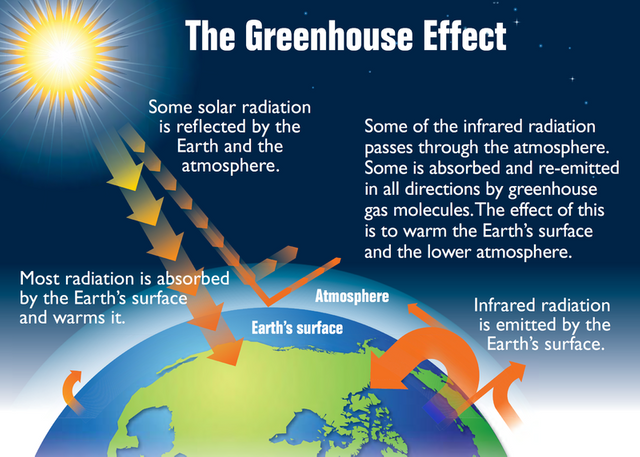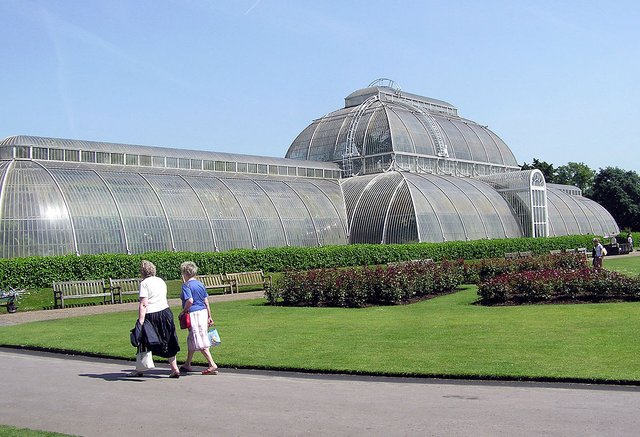The Greenhouse Effect! --- Earth's jacket!

Whether by design or evolution, earth continues to strike me as an intriguing and wonder-filled planet each day as I continue to explore the seemingly hidden wonders that make the world tick.
Did you know? Just like you would use a jacket to keep warm and slow down the emission of heat from your body on a very cold evening, so also do certain gases in our sky slow down the movement of heat energy away from the earth's surface. This we know as the Greenhouse effect.
Paraphrasing Wikipedia, The green house effect, is a process where certain atmospheric gases absorb and emit Infrared radiation, warming the atmosphere and thus, keeping temperature a bit higher than it would be, preserving energy in the earth for a while.
The greenhouse effect is unlike the ozone which occurs at a particular area in the sky. Rather, it occurs at diverse points/areas where gases like CO2, CH4, water vapour, NO2 etc are called greenhouse gases.
A talk a bit more about the science behind it, the gases responsible and how this concerns us as inhabitants.

The science behind the greenhouse effect.

Again, it all comes down to the brightest star in our solar system, -the sun-, and our sky's interactions with it's radiation.
When Sunlight reaches Earth, a good amount of that radiation is scattered, absorbed in the atmosphere, let through to the ground or reflected back into space. According to scientists, a good 26% of that radiation is reflected back into space, 19% is absorbed by the atmosphere and clouds and the rest absorbed by the ground.
The light energy which gets to the ground is absorbed and then radiated off into the atmosphere afterwards, as much longer wavelengths called infrared radiation (Which practically, is the heat we feel in our bodies, and on hot objects.)
This emitted infrared is absorbed by atmospheric air molecules with polar bonds (Bonds between atoms that differ in their electron-attracting abilities,) and they radiate this energy as they vibrate. As illustrated in the image, Some of the energy are radiated by these molecules into space, whereas, some of it is reflected back into the earth, heating the upper part of the atmosphere, and evenly raising the overall temperature of the sky -especially the troposphere where we live,- by the principle of thermal equilibrium. (Which states that two bodies in equilibrium must have the same temperature)
All of these processes is what keeps our surrounding warm and is responsible for the average atmospheric temperature. Without the infrared, earth's temperature would be about -18 degrees Celsius. Water would freeze, metabolism would slow down and most life form would die. The greenhouse effect pushes the earth's temperature up a few notches about 15 degree Celsius higher.

Greenhouses are literally "green houses" aren't they?
So, having known the science behind the greenhouse effect, one might wonder where the name comes from; why is it called "greenhouse"? Was it culled from a house made of trees and branches in the past, or is there more to it? Couldn't there have been a less colourful and serious-sounding name to tag this thing?
Ironically, the name "green" isn't so much about the colour and structure as it is about the content within it's walls. The name came as a result of it's use for storing plants and stuff that needed preservation in the past. And speaking of walls, greenhouses are made of glass! yes, Transparent glass walls and roof as thick as 3mm. The transparent roof and walls of the greenhouse allows for radiation from the sun pass through it and supply the much-needed energy for plant's photosynthesis. This radiation heats the air and surfaces within the greenhouse and soon, they get warmer and radiate infrared energy. When the Sun sets and the surrounding outside of the greenhouse gets relatively cooler, the temperature and humidity is higher because the glass walls and roof minimizes heat loss by trapping and reflecting matter and energy from escaping the it's walls. Hence, keeping the warmth a bit longer inside.
Greenhouses allow for a more flexible control over the factors that affect the environment and conditions where crops and plants grow. these conditions include temperature, humidity, light and shade levels, irrigation and fertilizers, etc, and could be used to grow seasonal food crops that otherwise wouldn't be available the year round, and as well as combat deficiencies in soil quality.
Cool enough, eh?

GREENHOUSE GASES. (GHG). --- We are green, in a house!

Unlike in Greenhouses where matter and energy is trapped and reflected, our atmosphere isn't made of glass, but it contains radiatively active gases that absorb and reflect these radiations inward, thereby keeping the heat -Just like a blanket would on a cold day-. we refer to them as the greenhouse gases.
Normally, when we discuss greenhouse gases and climate change, most people think Carbon (iv) oxide CO2 on autopilot. Probably because it is the most obvious source of Global warming (with images and videos of huge carbon emitting factories and flooding the internet.) However, it might not be the only one, neither is it even the most potent absorber of infrared in our sky, as there are several gases in little quantities in the atmosphere that are about 70% more potent than carbon, and these gases differ in their ability to retain energy and their lifetimes, - which is how long a single emission could remain active in the atmosphere-. Some could take a decade (like CH4), whereas, others could last for several thousands of years. And regardless of the source or area of emission, they remain in the atmosphere long enough to become mixed, and the measured amount of each greenhouse gas in a given area is the same.
Scientists had to come up with a standard that allows for these greenhouse gases to be compared on how much energy a particular volume of gas could absorb. They call this the GWP, which stands for the Global Warming Potential. For standardization, the GWP is the amount of energy that the emission of 1 ton of a greenhouse gas would absorb over a given time period.
For this to be possible, they needed some gas to act as a starting point for measurement, as well as a time period by which things can be measured. Since CO2 is more abundant in the atmosphere, and it has a lifetime of about 100 years, they chose its GWP to represent 1, and every other atmospheric gas are compared to the GWP value of CO2 to know their place.
The Greenhouse gases given in order of their quantity in the atmosphere include:
- Water vapour
- Carbon (IV) Oxide CO2
- Methane CH4
- Nitrous Oxide N2O
Water vapour
Water vapour constitutes between 40% to about 80% of the atmosphere and accounts for the largest percentage of the greenhouse effect. It is formed by the constant evaporation of water molecules from the surface of water bodies when sunlight heats it up.
Carbon (IV) Oxide CO2
CO2 is the compound formed when the elements oxygen and carbon come together. In terms of quantity in the atmosphere, CO2 is the most common GHG emitted by human activities. Since the dawn and dusk of the Industrial Revolution, the concentration of Carbon (IV) Oxide has increased to over 400 parts per million in the atmosphere, and continues to increase, as it is in constant circulation between plants, animals and the environment. This is referred to as the carbon cycle.
The sources of CO2 aren't biological alone, apart from cows and trees, there are also sources of emission like gas flares and fossil fuel burning, cement factories, oil rigs and cars.
Bush burning is one major source of CO2 too, as burning trees and woods release all the stored up CO2 back into the atmosphere.
Methane CH4
Methane as a greenhouse gas, is an organic compound formed by the covalent bonding of four hydrogen atoms to a single atom of carbon. It is naturally found both in ground mines and on the sea floor. However, it's major source of emission are gas factories, the production and transportation of coal as well as livestock dung and agricultural processes.
Methane in the atmosphere is over 25 times as potential as CO2! Our surroundings would have been way hotter if it lasted as long as CO2 does. Thankfully, it doesn't, and it's lifetime is just about a decade.
Nitrous Oxide N2O.
Nitrous Oxide is commonly known as laughing gas for it's chemical ability to cause laughter-like sensations in humans. However, as far as shiny white teeth and laughter go, N2O do not come from Dentists.
On the greenhouse charts for gases, N2O consists of about 5% in the atmosphere. Here's the shocker; with a GWP of 298, N2O is almost 300 times as potent at trapping heat as CO2 in the atmosphere! However, it is in trace amount in the atmosphere.
Major sources of N2O emission in the atmosphere are due agricultural processes that involve the use of Nitrogen fertilizers for crop yield. Also, It is naturally present in the atmosphere as part of the Nitrogen Cycle in our earth.
Fluorinated Gases:
Unlike other gases, fluorinated gases aren't natural at all. They are emitted from human activities such as the manufacture of semiconductors and the production of alumunium. The GWP of these gases are very high as they are the most potent and the longest-lasting greenhouse gases in the sky.
SF6 for example, is over 20,000 times as powerful as CO2 with a GWP of 22,800. However, since they are man-made, they are controlled and we find very trace amounts in the atmosphere.
Some of these gases include:
Hydrofluorocarbons (HFCs) , Perfluorocarbons (PFCs), Nitrogen Tetrafluoride (NF3) and Sulphur Hexafluoride (SF).

The Greenhouse effect and human contribution to Climate change.
The climate is simply the consideration of the weather pattern of a particular area over an expended period of time.
Climate change has always occurred on earth. In the past, these shifts were caused by natural cycles. Some are violent, some aren't. For example, there was the continental drift and the Ice age which occurred millions of years ago and shaped a greater part of our world, as well as volcanic eruptions that could propel dust and gases as high as the stratosphere.
The last century however, has seen an average global temperature rise of nearly 0.8oC measured at the tropospheric level. Sure, this might not really seem like much to you, but considering that prior to this the industrial age, the earth has warmed by only 4oC in 200 centuries since the peak of the Ice age, one really need to question how we live. Even though we have enjoyed technological revolutions, Human activities such as bush burning, gas flaring, farming and driving or petroleum based automobiles contribute to the source of greenhouse gases, which in turn increases global warmth and affect the climate.
While natural cycles such as plant growth, forest fires and volcanoes affect the amount of greenhouse gases in the atmosphere, human activities seem to accelerate greenhouse gases faster with our energy-hungry way of life. Statistics show that we have about 30% more CO2 in the atmosphere than in the mid 1700s, and according to projections, atmospheric CO2 could double to about 600 parts per million by 2050, which could have very devastating consequences.
Global warming can affect sources of food, water, habitats, health and other resources. And it's effects could include Melting ice sheets, burning rainforests, acidic oceans, heatwaves and droughts, vanishing glaciers, warming oceans and rise in sea level, and a lot others. For example, animals in the polar regions like the polar bear and ivory gulls have witnessed a 4oC rise in the local winter temperature. which has seen a part of their habitat decline due to melting ice caps.
By Cutting down trees on a large scale for building houses and bridges, we expose the be bare ground to more sunlight, which reflects and absorbs more sunlight, and also releases more greenhouse gases such as CO2, N2O and CH4. The 19th century factories, the steam engine, and a lot of other technologies relied on coal for functioning. The burning of these carbon-rich fossils from wood and dead animals release carbon into the atmosphere and contributes to global warming as well.

Reducing Greenhouse Gases

Global warming isn't a trivial issue, it affects everything on earth and care should be taken on how we chose to react to it. Getting every nation to agree on solutions is very difficult, and this is partly due to the fact that some of these nations (especially the underdeveloped ones) still rely on some of these technologies that are causing the problem. they could lose a lot by trying to replace these technologies. However, they have a lot more to lose by risking climate chaos.
Over time, there have been agreements and laws that were enacted by top organizations worldwide, to curb global warming by reducing the amount of greenhouse gases floating around. One of those rules is the Kyoto protocol, which made a start on greenhouse gas reduction in 1997 at a meeting in Kyoto, Japan.
Also, new and eco friendly technology could go a long way to solve global warming issues. Scientists are developing new ways to generate electricity, transport people and goods and make products use less energy. In fact, there is a massive hunt for cheap and reliable alternative energy that wouldn't require the use of any fossil fuel at all.
Nuclear power is considered in many developing countries as a primary source of electricity. i believe there's more, Renewables such as Geothermal energy, Wind power, Bio-fuels and solar power should be embraced widely.
Programmes should be held to educate farmers on the right time and the right way to apply Nitrogen-based fertilizers to the soil so that that N2O doesn't end up in the atmosphere.
Green transportation such as electric cars, train and bicycles should be encouraged as well.
In all, I believe this post isn't just about the science, nor is it filled with baseless and proof-less rants. No. It is meant to educate. People need to know more about the planet they live in, they need to realize what makes it tick. We need to understand how our activities affect our planet and ultimately, us.
Earth protects us, We really could do the same by keeping our skies Clean!
Thank you for reading,
@pangoli

References:
Alternative energy
Greenhouse effect and it's causes,
The Kyoto protocol, Wiki.,
Climate data and sciences




Being A SteemStem Member
Hey Pangoli, nice article, well presented.
I wanted to make a point, firstly I 100% agree that we must keep our atmosphere free of these harmful pollutants. I am not either denying climate change, jeez it's been crazy all through Europe lately. But what I'd like to say is that there may be further causes to our Global Warming. The solar system is infact moving into a higher energetic region of the galaxy, this in turn effects the Sun's behaviour. Planets and their stars have a very close relationship even with the vast distance between, by on the scale of things compared to atoms there is simliar proportions.
So to some up my point, we must take action to be kinder to our planet and environment, but also not to forget the bigger picture of the cosmic balance.
I posted something a while back about it, it wasn't stem directed just a short article I made.
Anyway take it easy my friend. Full Steem Ahead!
Thank you for pointing that out. no doubt, i didn't take my research beyond the earth's atmosphere. who knew that even the movement of the solar system affected this as well. lol.
I'll check your blog, friend. thanks for the heads up
It's fine, no criticism on my part :) We are all put here to learn, when I discovered this fact of the Sun moving into this zone I became very excited.
Nice one dude!
As a scientist, who is addressing the problem of global warming, I completely agree with you. This global problem is necessary to present and explain to all people, both in developed and undeveloped countries. It should be understood as the problem of every inhabitant on Earth, because if we don't solve it, there will be no life. So, thank you so much for writing and sharing this important topic and well written text with us!
Thank you for reading dear. It's interesting to know that there are scientists out there who care about the atmosphere and climate. Good to know you!
Pleasure is mine:)
The greenhouse effect caused by humankind might destroy most lives in the coming decades. Now is a good time to act. It perhaps is our only shot at avoiding extinction.
True. Even though i sound trivial about all of this, it really isn't the case. I mean, look at all the crap that could occur if this keeps on... Rising sea levels alone could wipe off habitats.
Thanks for this post it is an awareness that the green house effect is actually real, climate change is real. We need to be environmentally responsible, environmentally conscious so that we can sustain our environmental integrity and the environment will become friendly to us again
@pangoli I was made to understandfrom your post that nature its self-has a way of contributing to greenhouse effect but human activities is the super agent.
chlorofluorocarbons from industries cannot be compared to carbon from bush burning or gases from molten magma.
#steemsoccer1